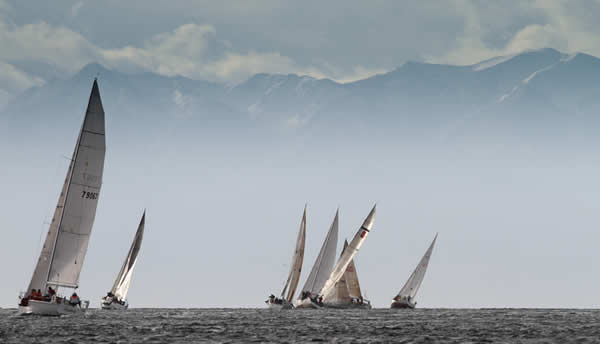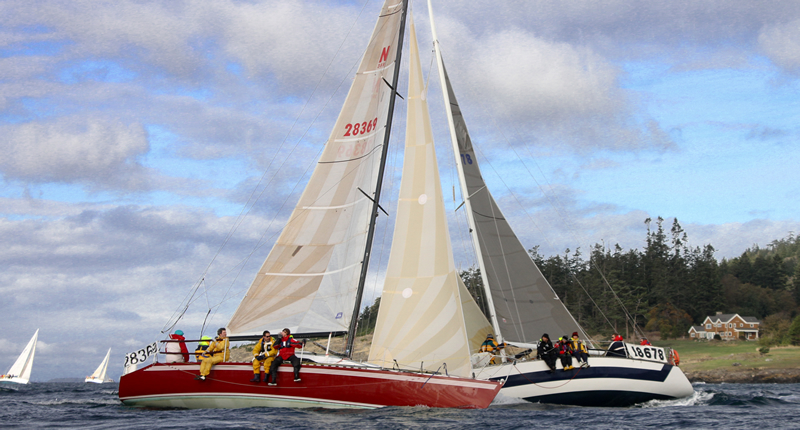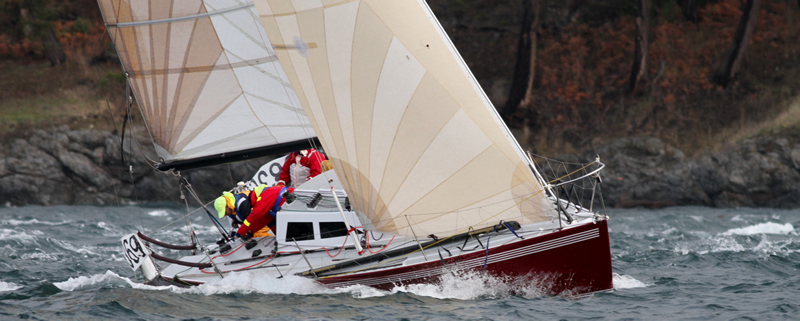
Pegasus leads the fleet into Haro Strait
A Beginner’s guide to the Round the County race, by Dan Newland
Close to Thanksgiving, many boaters love to sail “South of the Border”, however that generally assumes the US border, not the Canadian. But for 21 years, sailboats in the Puget Sound area have participated in a two day event that is more akin to an ocean race than an inland sail at a time of year that often brings storms, snow and freezing rain.
Being new to the area, we had not sailed on any of the larger, well attended and competitive races in the area. This year, we decided to change that and participate in what has become the popular and very challenging, Orcas Island Yacht Club “Round the County” Race. The RTC has been always been a little bit different. The race circumnavigates San Juan County in November when sane people are wearing ski parkas, not foul weather gear. It also alternates between clockwise on even years and counterclockwise on odd years. Here, you are surrounded by snow capped mountains and clear water with fir, cedar and maple trees seeming to disappear into the water. And if it weren’t for the horizontal rain and wind whipped waves, I’m sure we would have seen just that.
The race starts early Saturday off Lydia Shoals on the southeastern corner of Orcas Island. This first leg is a bit over 34 miles and ends off Roche Harbor on San Juan Island. The race finish Saturday night is the start of a rollicking good party that ensues in a tent on the docks. The next day, the 31 mile second leg starts off the western edge of San Juan Island at Mosquito Pass and continues around back to the finish off Lydia Shoals. The racing is really good and the competition first class but it is done with a casual flair.
This year, we went around counterclockwise with strong currents with us for most of the day on Saturday but turning to adverse current and primarily beating all Sunday. Many top end boats that participate. This includes some of Seattle’s and Canada’s finest to make it a good international showing. There were several custom yachts such as Braveheart, a TP 52, Icon, a Perry Custom 65’, plus Flash, a 1D 48, a SC 70 and the list goes on. The sentimental favorite though was the 86’ schooner “Martha” built in 1906 for the Commodore of the St Francis Yacht Club hailing from our own Port Townsend. She has been lovingly restored and cared for by Robert D’Arcy and the Martha Foundation and is a favorite sight locally.
For 2009, there were 69 boats total in 6 classes. On board Pegasus XIV, we were in the middle rating band with our PHRF rating of 60. Braveheart rated the lowest at -75 and thus gave us 135 second a mile handicap. Since it is so cold and rainy this late in the season, many wonder “Why November?” The race is put on late so that there is likely to be wind, something often lacking in the summer. But wind or not, strong currents happen year round and are always tricky. Combine that with sailing through passes, behind mountains and next to sheer bluffs with lots of lifts, headers, lulls, blasts, kelp beds the size of houses and you have some serious strategies to consider. All that in addition to clairvoyant sail selection and the need to power up and down quickly!

Crossing tacks
This was the first big race for Peggy in the “Salish Sea” but we were going into it with a bit of a disadvantage since she is more downwind oriented. I designed her as an extreme ultralight being made almost entirely from intermediate modulus (extra strong and stiff) unidirectional carbon fiber and toughened resin. Weighing only 5100 lbs when launched and 36.8’ long, she is capable of extreme speeds but she is really optimized for downwind and this course favored reaching and upwind speed. For crew, we kept it light with only 6 when 8 would probably have been faster. We had two of our old crew and good friends, Dan and Carol Benjamin from the San Francisco Bay area while the rest were local crew. Mike Berman, Colum Tinley and Erik Coburn, all from Port Townsend had been racing with us after we moved here but none had done this race before. Linda was running shore support and what a chore that was! I don’t think you can run the race without it.
We delivered Pegasus from Port Townsend to Rosario harbor on Orcas Island the Friday, before the race, Nov. 6 leaving in cold and rain. We arrived around 3:30 in the afternoon, got our condo for the crew, then Linda picked us up and we were off for the skippers meeting and social at the Orcas Island Yacht Club. The club is an old church by the looks of it and definitely funky but the members are a fun group and make everyone welcome, a great group of folks. Weather was the biggest topic and it looked like rain and wind the whole time from the south changing to the southwest Sunday, then gale force winds Sunday afternoon into Monday.
We got up early Saturday to a cold front moving in and snow down to the 1000’ level the previous night. The temperature was in the high 30’s predicted to get to the high 40’s and possibly low 50’s later. We motored for a bit over an hour to the starting line where the wind was between 18 and 25 with a short nasty chop and prepared for a spinnaker start with a strong current trying to force boats over early. The rain was coming down hard obscuring the mountains but we could make out the first rocky turn in the course. The first start took off setting spinnakers heading into a gray haze with no discernable change from sky to water. Our start was conservative and we set the kite after the start quickly shooting to the lead since few can touch Peggy with a spinnaker up and in breeze.
With the current behind us at 2.5 knots and headed due north under full spinnakers, the first turn at 4.1 miles came quickly. We gybed to port a bit past Lawrence point since the left turn had us going downwind and we needed to keep the angles hot to keep Pegasus planing. Then a squall came through bringing more rain and some 30+ knot blasts that were also headers making for VERY tight and tough reaching. We were sustaining 16- 17+ knots for awhile but then one blast hit and we rounded up and were down for the count. We got her back up but the spinnaker had taken the wind pointer off the masthead crane so we lost some of our instrumentation like analog windpoint, true wind direction and true wind angle capabilities. No biggie. Now we were hard reaching heading WNW in strong breeze so we went up with the #3 jib.
That squall passed quickly as the fleet turned into the lee of Orcas, Clark and the other islands with clearing skies and winds varying from 3- 15 knots changing from a reach to a beat as we continued turning left for several miles of gorgeous sailing. But the weather was not yet done as another squall bore down for the Roche Harbor finish on San Juan Island. This had more wind and rain plus a big lift so a huge contingent of often overlapped boats came blasting through the finish on a rail down jib reach with flogging mainsails and big rooster tails. The fleet docked with the rain beating down but predictably, the sun returned with mild temperatures and laundry being hung to dry on booms everywhere.
Saturday night the crew stayed in some rustic cabins at Snug Harbor normally used for summer visitors meaning we had the place almost entirely to ourselves with the only other guests being another racing crew. It was tight, but OH so much more spacious and warm than camping inside Pegasus! It was drier, too but all of the hanging foul weather gear and clothing fogged the windows!
The start of the second leg on Sunday required a short motor through some rocky islands to Mosquito Pass. The wind was from the southeast and gusty with winds from 3-12 knots near the start line. This meant a lot of hard beating against a strong current. We were immediately struck by how much kelp there was and “Is the starting line REALLY straight into the wind AND current???” Everyone has seen starting lines with favored ends but I had never seen one STRAIGHT into the wind. It appeared that coming through on starboard was legal but the intent seemed to be to pass it on port so rather than risk a crash with port tackers, I opted for a port tack start to weather but that meant a LOT of close in maneuvers against 24 other boats and that a looser could be 200 yards behind right at the beginning.

Looking for tide relief
The first start had a lot of luffing, yelling and shouts of “PROTEST!” which could hardly be surprising given the start line we were given but I opted to press my luck for the top spot. We timed it well and to our delight, pulled of a perfect start with no protests, full speed and spot on the gun. But then we discovered there was a general recall so we had to do it all over again! We again won the #1 spot with clear air and an inside lane with a big left shift ahead. Racing in San Francisco Bay teaches you about dealing with current so I elected to go “Play in the dirt” and we headed in as close as we could to the beach and of course the kelp. With more favorable current, we were able to work ahead and inside for awhile but others saw our speed and came after us on the beach. With most boats in our fleet being larger and more optimized for upwind than us, we were slowly ground down but we struggled on. We started with the 155% M-1 genoa but the wind was building and the short tacking of this large sail was taking a toll on us so we changed down to the #3 jib. This beating leg was 19 miles but given the 1.5 – 2.5 knot current against us, the actual distance sailed was about half again longer and favored the faster boats. We picked up a few large ropes of kelp and were forced to back down twice which just kills you but dragging 20’ strands of 1” diameter bull kelp for 30 miles is worse so you can only grin and bear it and hope that others have the same luck. It must also be said that you really, REALLY want to have a well calibrated depth sounder! Starboard tacks were done with one eye on the depth and given the rocky shore, took us breathtakingly close to the rocks if the kelp didn’t force an earlier tack.
After 5 hours of countless short tacks, we rounded the southern most corner at Davidson Rock in a pack of 5 boats but once we popped the Code 2 spinnaker, we got launched surfing a bit over 17 knots with Dan Benjamin steering. We dusted the pack and headed into the next group of boats. Very quickly, we rounded Kellett Ledge turning a bit more north and downwind and popped the full size 1.5 oz kite. The wind was around 20 knots with some stronger gusts. This put us into passing gear and we rocketed past several more boats. The sun had come through and we were flying between majestic mountains, passing boats left and right. What could be finer? We soon turned the final corner heading due north, finishing at around 1500 hours as the leading edge of the approaching gale began to pass through bringing low clouds, more wind and rain.
We had raced hard and long and in the end, got third place in class which was surprising. Given the length of time spent against the current Sunday and the paucity of spinnaker time, I had figured we were not going to do well, but Peggy worked her magic again and pulled out a place when we had the deck stacked against us.
In the end, the strong adverse currents Sunday worked against the smaller boats and gave the larger, faster boats the edge to win all the marbles with one exception. The schooner Martha at the ripe age of 102 showed all the kids how it is done and won the whole thing. When it was announced she had won first overall, the room went crazy with applause as she was easily the hands down favorite boat there. She was well sailed and had a brain trust that most everyone else could only envy. She was not the fastest boat but she was extraordinarily well sailed and sailed smart. While we were short tacking Sunday, she slipped off toward Victoria, British Columbia, found a reverse current and was swept southeast. And the long power reaching in breeze Saturday didn’t hurt, either given her waterline. But she proved that she still had some moves to teach us youngsters.
It was a great weekend, an extraordinarily challenging race but it is an event that isn’t for everyone. If sitting around the pool after a race sipping Mai Tai’s is your thing, this isn’t for you but for those that do it, it is very special with most coming back again and again.
We will be back to race again!
Here is a link to the OIYC website with information on the race and more photos of the race: